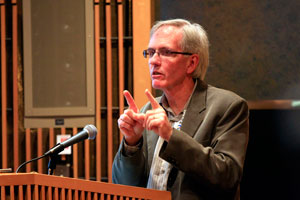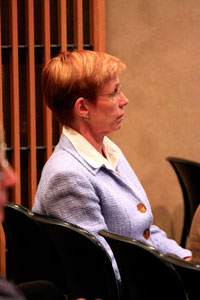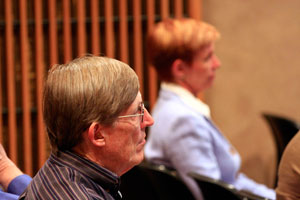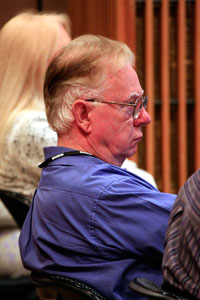
Environmental Factor, June 2008, National Institute of Environmental Health Sciences
SBRP Distinguished Lecture - Metal Oxides, Applications and Health Effects
By Melissa Fabiano
June 2008




Ian Kennedy, Ph.D., a Superfund Basic Research Program (SBRP)-funded engineer from the University of California, Davis (UCD), spoke to NIEHS scientists May 12 in Rodbell Auditorium. His SBRP Distinguished Lecture focused on “Metal Oxides: Applications and Health.”
Kennedy wears two hats as an SBRP investigator—he is an engineer by training and a biologist by association. According to lecture host and SBRP Acting Director Claudia Thompson, Ph.D., he exemplifies what the SBRP fosters — interdisciplinary studies and multidisciplinary research.
Kennedy’s ability to integrate engineering principles into cellular biology demonstrates this point. For example, drawing on his engineering background, he has studied how fluid mechanics contribute to the metal oxide deposition rate in the lung.
Extending this line of research, Kennedy is now developing biosensors using engineered nanomaterials and exploring the impact of the materials on human health. Kennedy has particularly focused on three metal oxides: iron (Fe), yttrium(Y) and zinc (Zn), and the ways the metal particles lead to inflammation. His investigations include the mechanisms of deposition of ultrafine particles in the lungs, which is associated with materials engineering and biological responses, and particle translocation, tracing the path(s) that a particle may or may not take into the cardiovascular, olfactory, nervous or other systems.
As a result of his research, Kennedy recognized that these (metal) nanoparticles are important catalysts for some inflammatory responses. The potential health threats of the nanoparticles are being analyzed through in vitro studies using human endothelial aortic cells.
Current research indicates that the particle size and surface area of metal are both correlated with inflammation, possibly as a result of the nanoparticle’s solubility. Kennedy emphasized that the surface area of the three metals is significant in that the surface area of the oxides appears to be inversely related to their toxicity. Of the three, Fe had the highest surface area and Zn had the lowest; however, Zn was more biologically active than Fe, which demonstrates the significance of metal type in determining bio-availability and induction of inflammation.
Kennedy and his UCD lab continue to conduct experiments focused on metal oxide nanoparticles using inflammatory markers and methods such as Reverse Transcription-Polymerase Chain Reaction (RT-PCR). The researchers also calculate dose by Inductively Coupled Plasma Mass Spectrometry (ICP-MS) and measure intracellular pH.
Recently, Kennedy and his team successfully injected cells with silica (SiO2) disguised as Fe, Zn, or Y nanoparticles. These nanoparticles were “decorated with different oxides” so that the silica oxide-sensitive colored dye could be injected into the cell to measure intracellular pH and particle solubility in endosomes. The Si nanoparticles were able to measure the pH and solubility as a result of the sensitive colored dye. This successful technique of probing cells is still being tested.
Kennedy pointed to five other up-and-coming technological advances by his UCD Lab:
- Experiments that examine flow conditions through translocation inflammatory response
- Lanthanide oxide nanoparticles developed to act as platforms for bioassays in sensor applications
- New ways of utilizing the useful features and unique properties of lanthanides for optical detection
- Nanoparticles with a magnetic core — and a luminescent shell — that can be used as platforms for sensing pesticides, food toxins, microbial DNA at bioremediation sites and for biomedical diagnostics for disease
- Application of new formats, such asgold shells, that can be heated with short laser pulses; the thermal wave can then be detected with temperature sensing phosphor nanoparticles. This technique could end up being a potential enhancement to Fluorescence Resonance Energy Transfer (FRET), which is used to measure longer distances.
Kennedy concluded the lecture on nanoparticles and biosensors with a summation of two critical points — that the composition of metal oxide nanoparticles, whether it is Fe, Y or Zn, plays an important role in toxicity and that luminescence metal oxide nanoparticles make ideal platforms for fast, small scale immuno- and DNA sensors.
(Melissa Fabiano is a communications specialist for MDB, Inc., a contractor for SBRP/WETP. She is a regular contributor to the Environmental Factor.)
"New Opportunities..." - previous story ![]()
![]() next story - "MIT Researcher..."
next story - "MIT Researcher..."
June 2008 Cover Page



